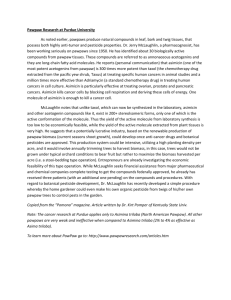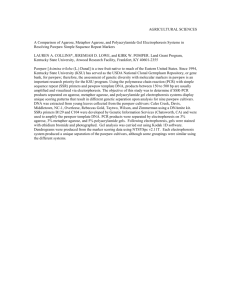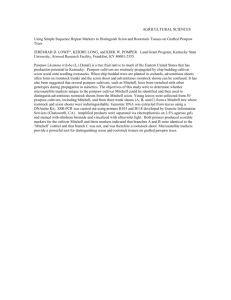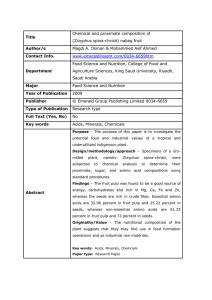Document 14105659
advertisement
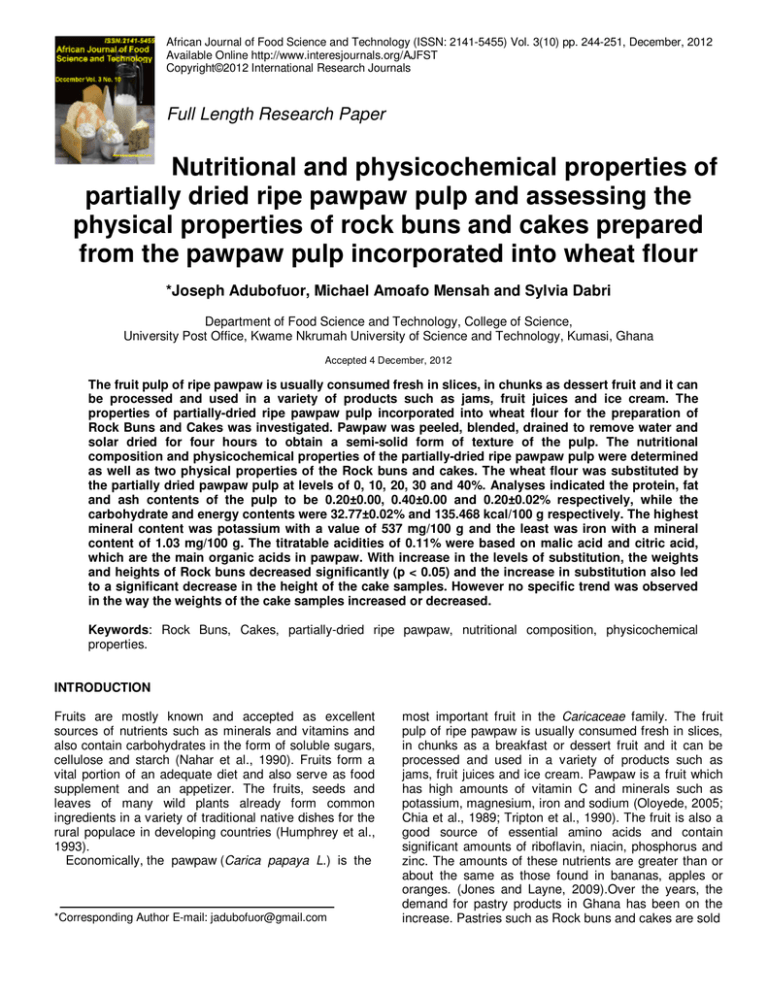
African Journal of Food Science and Technology (ISSN: 2141-5455) Vol. 3(10) pp. 244-251, December, 2012 Available Online http://www.interesjournals.org/AJFST Copyright©2012 International Research Journals Full Length Research Paper Nutritional and physicochemical properties of partially dried ripe pawpaw pulp and assessing the physical properties of rock buns and cakes prepared from the pawpaw pulp incorporated into wheat flour *Joseph Adubofuor, Michael Amoafo Mensah and Sylvia Dabri Department of Food Science and Technology, College of Science, University Post Office, Kwame Nkrumah University of Science and Technology, Kumasi, Ghana Accepted 4 December, 2012 The fruit pulp of ripe pawpaw is usually consumed fresh in slices, in chunks as dessert fruit and it can be processed and used in a variety of products such as jams, fruit juices and ice cream. The properties of partially-dried ripe pawpaw pulp incorporated into wheat flour for the preparation of Rock Buns and Cakes was investigated. Pawpaw was peeled, blended, drained to remove water and solar dried for four hours to obtain a semi-solid form of texture of the pulp. The nutritional composition and physicochemical properties of the partially-dried ripe pawpaw pulp were determined as well as two physical properties of the Rock buns and cakes. The wheat flour was substituted by the partially dried pawpaw pulp at levels of 0, 10, 20, 30 and 40%. Analyses indicated the protein, fat and ash contents of the pulp to be 0.20±0.00, 0.40±0.00 and 0.20±0.02% respectively, while the carbohydrate and energy contents were 32.77±0.02% and 135.468 kcal/100 g respectively. The highest mineral content was potassium with a value of 537 mg/100 g and the least was iron with a mineral content of 1.03 mg/100 g. The titratable acidities of 0.11% were based on malic acid and citric acid, which are the main organic acids in pawpaw. With increase in the levels of substitution, the weights and heights of Rock buns decreased significantly (p < 0.05) and the increase in substitution also led to a significant decrease in the height of the cake samples. However no specific trend was observed in the way the weights of the cake samples increased or decreased. Keywords: Rock Buns, Cakes, partially-dried ripe pawpaw, nutritional composition, physicochemical properties. INTRODUCTION Fruits are mostly known and accepted as excellent sources of nutrients such as minerals and vitamins and also contain carbohydrates in the form of soluble sugars, cellulose and starch (Nahar et al., 1990). Fruits form a vital portion of an adequate diet and also serve as food supplement and an appetizer. The fruits, seeds and leaves of many wild plants already form common ingredients in a variety of traditional native dishes for the rural populace in developing countries (Humphrey et al., 1993). Economically, the pawpaw (Carica papaya L.) is the *Corresponding Author E-mail: jadubofuor@gmail.com most important fruit in the Caricaceae family. The fruit pulp of ripe pawpaw is usually consumed fresh in slices, in chunks as a breakfast or dessert fruit and it can be processed and used in a variety of products such as jams, fruit juices and ice cream. Pawpaw is a fruit which has high amounts of vitamin C and minerals such as potassium, magnesium, iron and sodium (Oloyede, 2005; Chia et al., 1989; Tripton et al., 1990). The fruit is also a good source of essential amino acids and contain significant amounts of riboflavin, niacin, phosphorus and zinc. The amounts of these nutrients are greater than or about the same as those found in bananas, apples or oranges. (Jones and Layne, 2009).Over the years, the demand for pastry products in Ghana has been on the increase. Pastries such as Rock buns and cakes are sold Adubofuor et al. 245 Plate 1. Round female pawpaw of the ‘Solo Hawaii’ variety in shops and snack bars located along the streets in the urban centers. As the demand for pastry products increase, the cost of ingredients and products also becomes very expensive (Dotsey, 2009). This high cost is due to the fact that the principal ingredient in making pastries is wheat which is imported into the country because the prevailing climatic conditions and soil types in Ghana do not support its local cultivation. Some fruits such as ripe bananas have been used together with wheat flour by some bakers to bake banana cakes and such products have been sold on commercial basis. Even though pawpaws are cultivated locally in Ghana and are not so expensive on the market, processed food products from the fruit are scarcely found on the market and shopping centres. Its use has been limited solely to minimal processing in the form of packaged cut fruits or cut fruit blends which are sold by some food vendors who carry such products from place to place. Ripe pawpaws also have a short shelf life of two to three days at room temperature (Layne, 1996) and for adequate period of storage the fruit must be refrigerated. In spite of its limited uses, there is commercial potential for pawpaw pulp to be extracted, stored and utilized in yoghurt production, baked goods, flavouring juices and other products. Such processed products have become increasingly acceptable to today’s consumer. (Templeton, 2003).The objective of this research work was to determine the nutritional composition and physicochemical properties of partially-dried ripe pawpaw pulp as well as assess the physical properties of Rock Buns and cakes produced from the pawpaw pulp incorporated into wheat flour. MATERIALS AND METHODS Source of raw materials Pawpaws (Solo Hawaii variety) were obtained from a farm at Efiduase, a town in the Ashanti Region of Ghana. Pastry flour, margarine, baking powder, sugar, nutmeg, pineapple and vanilla essences were obtained from Ayigya market in Kumasi (plate 1). Sample preparation of partially-dried pawpaw pulp Two pawpaw fruits weighing 1kg and 0.96 kg were washed and peeled. The seeds were removed and the pulp was cut into uniform sizes and blended into a puree. The puree was transferred into a cheese cloth to allow the juice to drain out until no further liquid from the pulp drained out and the weight was taken. The pulp was then poured on a drying tray and solar dried for 4 hrs to give a firm soft texture for analyses. Plate 2 shows a picture of the partially-dried pawpaw pulp. Proximate analyses of partially-dried ripe pawpaw and pulp The moisture content, ash, fat, crude fibre, crude protein 246 Afr. J. Food Sci. Technol. Plate 2. Sample of partially dried ripe pawpaw pulp were determined using AOAC (1990). The carbohydrate content was determined by difference. The Energy content was determined using the Atwater Factors. from 100. Determination of total sugars Determination of the mineral composition of partiallydried pawpaw pulp Sample Preparation The mineral analysis was carried out using the Atomic Absorption Spectroscopy. An amount of 10.1094g of partially-dried pawpaw was weighed into a porcelain crucible. It was placed in a muffle furnace and ashed at 500˚C overnight. The white ash obtained was dissolved in 10% HNO3. The solution was then boiled to ensure complete dissolution of the ashed residue. After cooling for some time, it was filtered into a 100ml volumetric flask. The filtrate was finally diluted to the mark with distilled water and mixed well. Before the readings of the sample on the Atomic Absorption Spectroscopy, (AAS), standards for calibration were prepared. All elemental standards were stock standard of 1000 mg/L. Calibration standards were prepared by serial dilution of the various stock standards with 10% v/v HNO3 solutions. The minerals determined were Potassium (K), Sodium (Na), Magnesium (Mg), Iron (Fe) and Calcium (Ca). Physicochemical properties of partially dried ripe pawpaw pulp Determination of total solids The percentage total solid in the partially dried pawpaw pulp was determined by subtracting the moisture content A digital Hand-held Refractometer was standardized with distilled water. A slurry was prepared from the partiallydried ripe pawpaw pulp by mixing 10 g of the sample in 90 ml of distilled water and a drop placed on the surface of the Refractometer at 25o C to determine the sugar content. Determination of pH Exactly 10 grams of the partially dried pawpaw was weighed and mixed with 90 ml of distilled water. The pH was determined using the pH Tutor Bench Meter. Determination of titratable acidity Titratable acidity was determined using the method described by Karl et al., (1993). A clean burette was filled with 0.1 N NaOH solution. A volume of 200 ml of boiled distilled water was placed in a 300 ml beaker and 3 drops of 1% phenolphthalein indicator was added. The 0.1 N NaOH solutions were added in drops to the distilled water while swirling until a faint pink colour was obtained. The level of the NaOH in the burette was noted and recorded as blank. Slurry was prepared from the partially dried ripe pawpaw pulp and 5 ml of the slurry was added to 200 ml distilled water. The 0.1 N NaOH from the burette was added in drops to the mixture while swirling until a faint pink colour was observed. The volume of the NaOH solution used in titration was noted and recorded. Adubofuor et al. 247 Table 1. Proportions of wheat flour and pawpaw pulp used for formulation Sample A B C D E Wheat flour (%) 100 90 80 70 60 Calculation of the titratable acidity was based on citric and malic acids. Partially dried pawpaw pulp (%) 0 10 20 30 40 dried pawpaw was used. The batter from each bowl was then filled into their respective labelled layered baking cans of the same shape and size and baked at 160 °C for 35 minutes. Formulation of blends from wheat flour and partiallydried ripe pawpaw pulp Preparation of Rock buns The proportions of wheat flour and partially-dried ripe pawpaw pulp used for the formulation are shown in Table 1. Baking of the formulated blends Preparation of Cake Samples Cakes were prepared according to AACC (2000) method with some modifications by using nutmeg, vanilla and pineapple essence as part of the ingredients. A mixture of sugar and margarine was prepared by mixing 1.25 kg of margarine and 650 g of sugar in a cake mixer (Kenwood Major Classic) for 50 minutes to ensure the mixture was well creamed. This was afterwards poured into a bowl. Thirty (30) eggs were also whipped in the mixer for 30 minutes and the whipped egg was poured onto the sugar and margarine mixture and beaten till a uniform mixture was obtained. Afterwards, 500 grams each of the egg, sugar and margarine mixture was then measured into 5 different bowls labelled with the ratios: 100:0, 90:10, 80:20, 70:30 and 60:40. To each bowl, 5 ml each of vanilla, pineapple essence and 2.5 g of sifted nutmeg were added and stirred evenly. To the bowl labeled 100:0, 250 g of soft flour and 15 g of baking powder were sifted into the creamed mixture in small amounts while beating. To the bowl labelled 90:10, 225 g of soft flour, 15 g of baking powder and 25 g of the pre-dried pawpaw was used, to the bowl labeled 80:20, 200 g of soft flour, 15 g of baking powder and 50 g of the pre-dried pawpaw was used, to the bowl labelled 70:30, 175 g of soft flour, 15 g of baking powder and 75 g of the pre-dried pawpaw was used and to the last bowl labelled 60:40, 150 g of soft flour, 15 g of baking powder and 100 g of the pre- All the five formulations were baked using the method described by (Ceserani and Kinton, 2008) with slight changes in the procedure by excluding eggs and diluted milk in the formulation. To each formulated blend, weighed and transferred into a bowl, exactly 5 g of nutmeg, 200 g of table sugar and 15 g of baking powder were weighed, sieved and added to the blends. Five (5) ml each of pineapple and vanilla essences were added to the mixtures. These were thoroughly rubbed in 250 g of margarine. A volume of 50 ml of water was added and mixed thoroughly until a slightly firm mixture was achieved. The mixture was distributed proportionally into greased patty tins of the same shape and volume and placed in a fairly hot oven at 1600 C for 50 mins. They were then removed and placed on a cooling rack to cool (plate 3 and plate 4). Determination of physical properties of Rock buns and Cakes Samples of Rock buns and Cakes were selected randomly from each blend and the weights and heights were measured using a digital scale and a metric ruler respectively. Statistical Analysis Means and standard deviations of parameters were determined. One-way Analysis of Variance (ANOVA) was used to determine significant differences, while multiple comparison test using Fisher 95% confidence intervals was used to establish differences among the means. 248 Afr. J. Food Sci. Technol. Plate 3. Rock buns from formulation ratio 90: 10 Plate 4.Rock buns from formulation ratio 100:0 RESULTS AND DISCUSSION Table 2 shows the proximate composition and energy content of partially-dried ripe pawpaw pulp. The moisture contents of most fresh fruits range between 81.30-91.50% (USDA, 2008).The initial moisture content of the ripe pawpaw was 91.73% which is slightly higher than the above stated range. Fruits with higher moisture content deteriorate quickly and are microbiologically unstable. The considerable reduction of the moisture content of the pulp to 63.53% could slow down microbial attack and preservation of the partiallydried pulp will require further refrigeration or freeze drying to extend the shelf life. It has been reported that the shelf Adubofuor et al. 249 Table 2. Proximate composition of partially dried ripe pawpaw pulp FOOD COMPONENT Moisture Ash Fat Fibre Protein Carbohydrate Energy(kcal/100g) PERCENTAGE (%) 63.53 ± 0.427 1.09 ± 0.097 0.40 ± 0.000 2.90 ± 0.141 0.20 ± 0.000 31.88 131.92 Table 3. The mineral composition partially dried ripe pawpaw pulp MINERAL Calcium (Ca) Potassium (K) Magnesium Sodium (Na) Iron (Fe) life of ripe fruits can be extended up to three weeks by refrigeration at 4◦C.(Layne, 1996). The ash content of the partially dried pawpaw was 1.09%. Fruits, fruit juices and melons have ash content ranging from 0.2–0.6%, while dried fruits have higher contents between 2.4–3.5% (Marshall, 2009). The ash content of the partially dried ripe pawpaw pulp was relatively lower than that of dried fruits. Generally Loss of moisture in foods leads to an increase in concentration of the nutrients (Morris et al., 2004). The ash content of pawpaw fruit is about 0.6% (Chia et al.,1989; Tripton et al., 1990) The removal of moisture resulted in a corresponding increase in the ash content but was not as high as the completely dried fruits. The percentage crude fat content was 0.40%. Fruits generally have low fat contents and the value of 0.4% is within the range of 0.1- 0.5% stated by Min and Ellefson (2009). Pawpaw is a good source of dietary fibre and has a content of 2.6% while the fibre contents of bananas and oranges are 2.4% and that of apples is 2.7%.(Jones and Layne, 2009) Pawpaw is quite a fibrous fruit and a decrease in the moisture content consequently increased the percentage crude fibre of the partially-dried pulp to 2.90%. Even though the protein content of the fresh ripe pawpaw has been stated to be 0.6%,. Some fruits contain less protein (USDA, 2008). The protein content of 0.2% of the partially-dried ripe pawpaw pulp was lower than the stated value. Belitz and Grosch (1999) stated that the amount of protein in fruits varies greatly with the fruit ripeness and variety. The difference may be attributed to fruit variety and ripeness. of VALUE (mg/100g) 53.80 ± 0.46 537.80 ± 0.48 34.43 ± 0.05 1.90 ± 0.06 1.03 ± 0.00 The carbohydrate content of the partially dried pawpaw pulp was 31.88%. The USDA (2008) has reported that most fruits contain appreciable amounts of carbohydrate ranging from 10.4-19.9%. Humans derive 55-65% of their energy mainly from carbohydrates. The pulp can be used to replace or supplement fatty choices for deserts, snacks or as fillings for bakery items. (Rosivalli and Vieira, 1992) The mineral composition of the partially-dried ripe pawpaw pulp is represented in Table 3. The predominant minerals in the pulp are potassium and calcium. The potassium content was 537.80 mg/100 g. Calcium and magnesium were present in moderate amounts of 53.80 mg/100 g and 34.43 mg/100 g respectively. Sodium and Iron were 1.90 mg/100 g and 1.03 mg/100 g respectively. According to Jones and Layne (2009), pawpaw is rich in potassium, magnesium and calcium with the values being 345, 113 and 63 mg/100 g respectively. The differences may be attributed to the difference in varieties and to some losses occurring during the draining of the juice from the pulp These mineral analyses are nutritionally important because it is known that inorganic mineral elements such as potassium and calcium play important roles in the maintenance of normal glucose-tolerance and in the release of insulin from beta cells of islets of Langerhans. Sodium, iron, and calcium play important roles in controlling hypertension, preventing anemia, and impeding the development of osteoporosis, respectively (Choudhary and Bandyopadhyay, 1999). Table 4 shows the physicochemical properties of the partially dried pawpaw pulp. The total solid was 36.47 % which gives an indication of the dry matter of the partiallydried pulp. Belitz and Grosch (1999) stated that the dry 250 Afr. J. Food Sci. Technol. Table 4. Physicochemical properties of partially dried ripe pawpaw pulp PARAMETER Total solids (%) Total sugars(˚Brix) pH Malic acid (%) Citric acid (%) VALUE 36.47 ± 0.07 6.80 ± 0.07 5.05 ± 0.07 0.114 ± 0.01 0.109 ± 0.01 Table 5. Physical Properties of Cake Samples with different proportions of pawpaw pulp RATIOS Average Parameters Weight (g) Height (cm) 100:0 a 90:10 a 80:20 a 70:30 a 60:40 a 36.89±1.76 34.67±2.87 36.44±3.25 35.22±1.48 37.11±2.37 2.89±0.21 2.50±0.11 2.42±0.08 2.14±0.12 2.11±0.09 a b b c c Mean values with different superscripts in the same row indicate significant differences (p≤0.05) matter of the fresh edible portion of pawpaw is 11 % and total sugar content is 9 %. The ‘Solo Hawaii’ variety is a sweet variety of pawpaw and the reduced sugar content of the pulp (6.80 %) may be attributed to the losses due to the draining of the juice from the pulp of the fruit. The pH value of 5.05 of the partially-dried ripe pawpaw pulp is characteristic of the fruit. Pawpaw is a low acid fruit and the pH ranges between 5.0 and 5.5.(Schobinger, 2001). Generally, most acid fruits have pH values ranging from 2.80 to 4.30. Within this range most bacteria cannot grow and products could be stored without rapid deterioration (Rahman, 2007). However, most bacteria grow between pH ranges of 5.0-9.0 (Black, 1999). The pH values of a product are affected by the variety of the cultivar, seasonal variations, maturity owing to growing conditions and geographical areas (Rahman, 2007). To prevent microbial attack and subsequent spoilage of the sample, the pulp would have to be refrigerated at a low temperature to extend the shelf life. Malic and citric acids are the predominant organic acids in pawpaw. (Schobinger, 2001). The titratable acidities of the pulp were 0.114% and 0.109% for malic and citric acids respectively The total titratable acidity for both malic and citric acids, has been stated by Belitz et al., (2004) to be 0.1%. Acids can exist at levels below detection limits or they can be the preeminent substance present in the food. Acids tend to decrease with the maturity of fruit while sugar content increases (Sadler and Murphy, 2009). The low percentages of the acids obtained show that the pawpaw used was fairly matured. Physical parameters evaluated were the heights and weights of the prepared cake samples and are represented in Table 5. This was carried out to establish any possible correlations between the level of substitution of the pawpaw pulp and the physical properties. There was no significant difference in the weights of the samples (p>0.05) and no special order in the way the weight of the samples increased or decreased. However, the height of the samples showed a significant difference (p≤0.05) as it decreased from the control sample (100:0) to sample (60:40). As the quantity of the pawpaw pulp increased in the dough, the heights of the cake samples decreased. This trend could be due to the decrease in wheat flour (protein content) and hence the decrease in the amount of gluten which is responsible for the elasticity of the batter by causing it to extend and trap carbon dioxide for aeration of the dough during mixing and baking. The aeration provides a light, porous cell structure, fine grain, and a texture with desirable appearance along with palatability to baked goods (Bennion and Bamford, 1997). The individual weights and heights of the different formulated products are shown in Table 6. The mean weights and heights ranged from 64.00 to 75.20 g and 40.20 to 50.20 g respectively. There were significant differences (p<0.05) between the weights and heights of the samples of the Rock buns. As the levels of substitution of the partially dried pawpaw pulp increased, the weights and heights of the Rock buns also decreased. Product E (60:40) had the lowest mean weight and height because it had the highest level of substitution of 40% of the partially dried ripe pawpaw pulp and consequently the lowest protein (gluten) content. The protein levels of the wheat flour accounts for the elasticity of the dough by causing it to extend and trap the carbon dioxide generated during the heating process and thereby preventing it from collapsing (Hui et al., 2006). Gas retention is a property of flour protein which must be sufficiently extensible and strong enough to allow the dough to rise and prevent the gas from escaping (Kent and Evers, 1994) The different levels of substitutions had an effect on the process of dough development and on Adubofuor et al. 251 Table 6. Physical properties of samples of Rock Buns with different proportions of pawpaw pulp Product A( 100:0) B(90:10) C(80:20) D(70:30) E(60:40) Weight (g) a 75.20 ± 1.49 b 72.60 ± 1.52 c 69.60 ± 1.14 d 67.60 ± 0.89 e 64.00 ± 1.00 Height (cm) a 50.40 ± 1.14 b 48.80 ± 1.30 c 46.20 ± 0.84 d 43.60 ± 0.55 e 40.20 ± 0.45 Mean values in the same column followed by different superscript indicate significant differences (p≤0.05) the weights and heights of the Rock buns. CONCLUSION The proximate analyses showed that the partially dried ripe pawpaw pulp had moisture and fibre contents of 63.53% and 2.90%. Ash, protein and fat having low contents of 0.20, 0.20 and 0.40% respectively. The carbohydrate and energy contents, were 32.76% and 135.468 kcal/100 g respectively The mineral analyses also indicated that potassium (537.80 mg/100 g) was the highest followed by calcium (53 80 mg/100 g) with the least being iron (1.30 mg/100 g) .The incorporation of the pawpaw pulp in wheat flour indicated that the weights and heights of Rock buns decreased significantly (p < 0.05) with increase in the levels of substitution. The increase in substitution also led to a significant decrease in the height of cake. However no specific trend was observed in the way the weights of the cake samples increased or decreased. REFERENCES AACC (2000). Approved Methods of American Association of Cereal Chemists, 10th edition. The American Association of Cereal Chemists, Inc., St. Paul, MN. AOAC (1990). Official Methods of Analysis, 13th ed, 1990; AOAC International, Gaithersburg, MD. Belitz HD, Grosch W (1999) Food Chemistry second edition 749:756757 Belitz HD, Grosch W, Schieberle P (2004). Food Chemistry, third revised Edition. pp. 814 Bennion EB, Bamford GST (1997). The technology of cake making, edited by Bent, A. J. Sixth Edition. London. Blackie Academic and Professional. Pp.116-130. Black JG (1999). Microbiology: Principles and Explorations, 4th edn. John Wiley and Sons Inc., Chichester. pp. 26. Ceserani V, Kinton R (2008). Practical Cookery, 10th Edn, John Wiley and Sons, New York: pp. 67. Chia CL, Nishina MS, Evans DO (1989). Papaya. Commodity Fact Sheet PA-3(A) Fruit, Hawaii Cooperative Extension Service, CTAHR, University of Hawaii. Choudhary KA, Bandyopadhyay NG (1999). Preliminary studies on the inorganic constituents of some indigenous hyperglycaemic herbs on oral glucose tolerance test. J. Ethnopharmacology, 64:179-184. Dotsey P (2009). The use of cocoyam, cassava and wheat flour composite in the production of rock cakes, HND Dissertation, Cape Coast Polytechnic, Cape Coast, Ghana, 1:7-40. Hui YH, Corke H, Cross N, De Leyn I, Wai-Ku-Nip (2006). Baking st Products: Science and Technology, 1 edition. Blackwell Publishing Ltd, 2121 State Avenue, Ames, Iowa 50014, USA: pp. 13, 21, 28, 3638, 42-44, 95, 98, 105, 110 and 165. Humphrey CM, Clegg MS, Keen CL, Grivetti LE (1993). Food diversity and Drought survival: The Housa example. Int. J. Food Sci. Nutr. 44: 1-16. Jones SC, Layne DR (2009). Pawpaw Description and Nutritional Information, Kentucky State University Cooperative Extension Program. Pawpaw Research Project, Community Research Service, Atwood Research Facility, Frankfort, KY pp. 40601-2355. Karl LW, Travis SH, Marilyn BO, Murli RD (1993). Making Wine for Home Use, State Fruit Experiment Station, Southwest Missouri State University, Mountain Grove. Kent NL, Evers AD (1994). Technology of Cereals: An Introduction for students of food Science and Agriculture, Elsevier Science Limited pp.198 Layne DR (1996). The pawpaw [Asimina triloba (L) Dunal]: A new fruit crop for Kentucky and the United States. Hort-Science 31:777-784 Marshall MR (2009). Ash Analysis In Nielsen, SS (2009). Food th Analysis, 4 edition. Springer Science+Business Media, LLC, 233, Spring Street, New York, 10013, USA pp. 107 Min BD, Ellefson WC (2009). Fat Analysis In Nielsen SS (2009). Food th Analysis, 4 edition. Springer Science+Business Media, LLC, 233, Spring Street, New York, 10013, USA: 120 Morris A, Barnett A, Burrows OJ (2004). Effect of processing on nutrient content of foods.www.paho.org/English/CFNI/cfni-caj37No304-art3.pdf visited on August 18:2012 Nahar N, Rahman S, Mosiihuzzaman M (1990). Analysis of carbohydrates in seven edible fruits of Bangladesh. J. Sci. Food Agric. 51: 185-192. Oloyede OI (2005). Chemical Profile of Unripe Pulp of Carica papaya. J. Nutr. 6:379-381. nd Rahman SM (2007). Handbook of Food Preservation, 2 edn. CRC Press, USA. pp. 287-288. Rosivalli LJ, Vieira ER (1992) Elementary Food Science, third edition.19:386 Sadler DG, Murphy AP (2009). PH and Titratable Acidity In Nielsen SS th (2009). Food Analysis, 4 edition. Springer Science+Business Media, LLC, 233, Spring Street, New York, 10013, USA: 228:233. Schobinger U (2001) Handbuch der Lebensmitteltechnologie: Fruchtund Gemuesesaefte 3.Auflage, Eugen Ulmer GmbH. pp. 262. Templeton SB, Marlette M, Pomper KW, Jones SC (2003). Favourable taste rating for several pawpaw products. Hort technology 13(3): 445448 Tripton TV, Yokoyama KM, Wanitprapha K, Nakamoto ST, Chia CL (1990). Papaya Economic Fact Sheet #10. Department of Agricultural and Resource Economics, CTAHR, University of Hawaii USDA (2008). USDA Nutrient Database for Standard Reference. Release 21, (2008).
